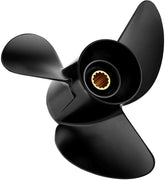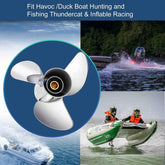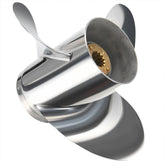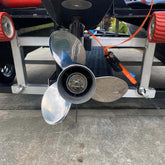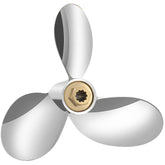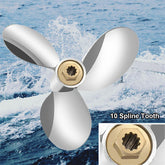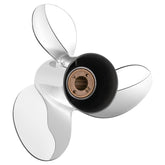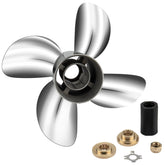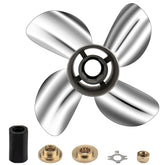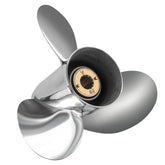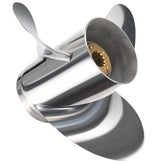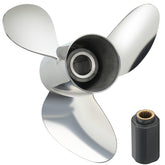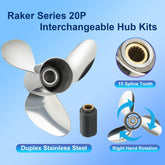Yamaha vs Mercury — Pick the Right Prop
If you want predictable performance and fewer returns, treat a prop swap like an engineering task — not a shopping guess. This concise field guide tells you exactly what to measure, what to test, and which replacement route to choose when comparing Yamaha and Mercury propellers. No fluff — just the checks and decisions that matter on the water.
1) Start by collecting the three decisive facts
Before you buy anything, get these as clear photos and values. They resolve roughly 80% of fit issues:
-
Prop stamp (diameter × pitch) — usually stamped on the hub or blade (example:
13 x 19). -
Hub & spline details — a clear photo of the prop hub interior and the lower-unit input shaft, or the lower-unit part number.
-
Engine ID + baseline WOT RPM — engine make/model/year/serial and a measured wide-open-throttle RPM with your current prop and a typical load (people + fuel + gear).
If you prefer, upload these directly when you order at our online store: VIF Propeller Online Store.
2) Mechanical fit beats logo every time
A Yamaha badge on a blade means nothing if the spline count/profile doesn’t match the lower unit.
-
Must-match: spline profile and count, hub outer diameter and seating face.
-
If they match: you have a direct-fit candidate — install and validate WOT RPM.
-
If they don’t: you have three practical options (below).
-
Avoid generic adapters for heavy use — they introduce offsets and altered torque transfer that cause vibration and premature wear.
For direct brand-specific replacements, browse Yamaha and other brand collections on our site: propeller for Yamaha — and visit the main store at vifprop.com.
3) Three practical replacement routes (choose one)
When mixing Yamaha and Mercury hardware, select the route that fits your risk tolerance and duty cycle:
-
Direct fit (fastest, if compatible)
-
Requirements: identical spline/profile and sufficient clearance.
-
Action: fit the prop and run the WOT test. If RPM sits in the manufacturer’s band, you’re done.
-
-
OEM hub swap (serviceable compromise)
-
Swap the hub to match your lower unit spline while retaining the prop body.
-
Only possible when the prop design supports hub replacement and when hub dimensions are compatible.
-
-
Custom prop with the correct spline (recommended for reliability)
-
Manufacture the blade with the exact spline profile, diameter/pitch and blade geometry for your lower unit and mission.
-
Eliminates adapter offsets, reduces vibration risk and is the long-term route for towing, commercial use or frequent high-load runs.
-
If you want to understand how propellers are actually produced — and why a custom route gives advantages — see our factory overview: How Boat Propellers Are Manufactured.
4) Diameter × pitch: tune by RPM, not by guess
Use WOT RPM as your validation metric.
-
Record baseline WOT with your current prop under a typical load.
-
Compare to the engine maker’s recommended WOT band.
-
WOT above band → prop too small / pitch too low → increase pitch/diameter.
-
WOT below band → prop too large / pitch too high → reduce pitch/diameter.
-
-
Make changes in small steps (±1–2 inches pitch) and retest under identical load/trim conditions.
This iterative, data-driven approach finds the balance between hole-shot, cruise efficiency and top speed without overstressing the engine.
5) Material and blade count — match to mission
Match material and blade count to how you use the boat:
-
Aluminum — cost-effective, repairable after minor strikes; ideal for recreational setups.
-
Stainless steel — stronger, thinner sections, better top-end efficiency; preferred for high-power or performance use.
-
Blade count — 3-blade = general compromise; 4-blade = stronger low-end thrust and better loaded handling (towing/watersports); 5-blade = niche (extreme low-speed thrust/stability).
Check our performance lines and hot sellers for examples and ideas: Hot-selling propellers.
6) Installation & verification checklist (practical)
-
Photograph splines, hub rubber and shaft before installation.
-
Use matched hardware: prop nut, washer and cotter pin (VIF supplies hardware kits).
-
Initial run: idle → low speed → WOT; log RPM, trim and load.
-
If vibration appears, stop and inspect shaft runout, hub condition and blades — don’t keep running.
We provide matched hardware and water-pump repair kits along with props to simplify installation and avoid mismatched parts.
7) Common field failures — what they usually mean
-
New vibration after swap: hub rubber deterioration, spline wear, or slight shaft bend — not always blade geometry.
-
Lower top speed + higher fuel burn: typically pitch mismatch or blade damage.
-
Slippage under load: worn or incorrect hub — replace hub or fit a true direct-fit prop.
8) What to send to get a fast, correct quote
For the quickest, most accurate response include on your order or email:
-
Engine brand/model/year/serial
-
Clear photos: prop stamp, prop hub interior, lower-unit input shaft
-
Baseline WOT RPM and typical load (people + gear)
-
Desired outcome: acceleration, top speed, towing, or long-life replacement
Upload specs or place orders here: VIF Propeller Online Store. For brand-specific browsing, see our collections for Yamaha, Honda, Volvo and others:
Closing — make it an engineering cycle, not a shopping gamble
Pick a route that matches how you use the boat: direct fit for simple swaps, hub swap if the prop supports it, or a custom VIF prop for long-term reliability. Send photos and WOT RPM to VIF via the online store and you’ll get engineer-rated options (direct-fit, hub-swap, custom) plus the exact hardware and pump kits you need to install them.
Order / Quote: https://vifprop.com/ — upload your photos and specs for the fastest, safest match.


